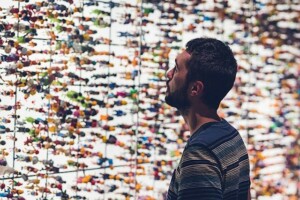This year marks 450 years since William Shakespeare was born, and both the man and his work continue to be celebrated across the world.
With his contribution to English literature, the theatre and our cultural life being so immense, Shakespeare’s birthplace and hometown are vitally important to our heritage. The Shakespeare Birthplace Trust – formed in 1847 when Shakespeare’s birthplace in Stratford-upon-Avon went up for auction – is the world's leading charity charged with celebrating and promoting the works and life of the great man.
The Trust now cares for a total of five houses: Shakespeare’s Birthplace; Nash’s House and New Place – the site of Shakespeare’s Stratford-upon-Avon home for the last 19 years of his life; Anne Hathaway’s Cottage ;Mary Arden’s Farm – the family home of Shakespeare’s mother, Mary Arden, before she married, and  Hall’s Croft – home to Susanna, Shakespeare’s eldest daughter and her physician husband, John Hall.
Hall’s Croft – home to Susanna, Shakespeare’s eldest daughter and her physician husband, John Hall.
Dr. Diana Owen (right) took over as Director of the Shakespeare Birthplace Trust in 2007. She talked to Blooloop about her financial and strategic transformation of the Trust; the hurdles she faced initially and challenges and opportunities as the Trust moves into the future.
A Tide in the Affairs
Born and brought up in India, Diana was educated in Winchester and at Leeds University, culminating in a PhD on British propaganda in the Second World War.
“I started out as a historian; my PhD was a history PhD. When I was at school doing my ‘A’ levels the Tudor period absolutely fascinated me, but my PhD was actually on the history of the Second World War.”
After her PhD, Diana went into publishing then, in 1988, after having a child, she decided on a change of career that would allow for a better work/life balance, and saw a job advertised with the National Trust which she felt, given her interest in historical figures and, more particularly, historical landscape and architecture, would suit her ideally.
“I ended up working in the National Trust for twenty years in different parts of the country, managing different types of historic property and landscapes.”
 She managed Petworth in West Sussex, then became Area Manager for the National Trust’s properties firstly in Hampshire, London and the Isle of Wight, then in West Sussex and South Surrey, with responsibility for major infrastructure projects and public enquiries.
She managed Petworth in West Sussex, then became Area Manager for the National Trust’s properties firstly in Hampshire, London and the Isle of Wight, then in West Sussex and South Surrey, with responsibility for major infrastructure projects and public enquiries.
When she saw the position at the Shakespeare Birthplace Trust advertised she felt that her experience with the National Trust had given her a very relevant range of skills. She adds: “Of course, I hadn’t quite factored in the Shakespeare, which makes it a unique organisation.”
Turning Things Around
At the time of her appointment, the Shakespeare Birthplace Trust was in trouble, facing a  declining visitor base. Since visitors account for 86% of income, losing money every year, which had to be made up from reserves, put the Trust in a very weak position which clearly wasn’t sustainable.
declining visitor base. Since visitors account for 86% of income, losing money every year, which had to be made up from reserves, put the Trust in a very weak position which clearly wasn’t sustainable.
“The declining numbers were for a number of reasons: 9/11 and the drop-off of American visitors; a strong pound; the Iraq wars – all sorts of reasons, but it had led to a real lack of confidence in the organisation; a lack of ambition, as well.”
Diana’s first challenge was to rebuild the visitor side of the business, which was achieved firstly by focusing on the customers and their requirements, and secondly by putting Shakespeare’s words and language back into the visitor offer.
“…Because you could go all round the houses in Stratford, and all round the exhibitions, and not actually hear Shakespeare’s language being spoken.”
Introducing Actors and Behaving Like a Charity
A new audio-visual exhibition was installed and actors were introduced into the experience – in the garden at the Birthplace an acting company, Shakespeare Aloud, now performs extracts from famous speeches. This has made a massive difference, focusing the experience on Shakespeare’s words and works and the story of Shakespeare in Stratford rather than simply a general history of Tudor life and times.
Having the actors (and multi-lingual guides) helps fulfil the expectations of a diverse assortment of visitors. Rather than a fixed, take-it-or-leave-it style presentation there is a great deal of person-to-person interaction, and the guides and actors – many of whom are also multi-lingual – are responsive and tailor what they talk about according to the individual visitors.
This works well in the small spaces of the Stratford buildings: the flexibility of discourse means groups can be kept moving rather than becoming static in one place for a long time.
“The other thing we did was to start to behave more like a charity, ” says Diana.
This involved activating the Gift Aid scheme on admission tickets; revitalising the ‘Friends’ organisation; actively looking for grants to support the work, something that hadn’t previously been done in any focused way; and setting up a fundraising team.
Income and Education
It took less than three years under Diana’s directorship for the finances to be turned around. The Trust now generates a surplus, which is re-invested, going back into repairs to the buildings, improving the visitor offer and mounting new exhibitions.
Having solved the Trust’s immediate problem of dwindling visitor numbers and depleted resources, Diana and her team are thinking increasingly of ways to improve other income streams: as she points out, “There’s clearly a limit to the number of people you can put through the Birthplace in any one year.”
Online retail is one way of generating income, and the Trust has just gone into its first licensing agreements for a range of pens and a range of toiletries.
“We’re looking at increasing our online educational activities as well: we’ve got a number of new products for schools and for the general enthusiast which will be coming through in the next couple of years as online courses. And we’ve just done our first M.O.O.C – ‘Massive Open Online Course’ – with Warwick University, on Shakespeare, an impressive resource on the Future Learn platform.”
The intention is to generate communities of interest and new audiences, and to market products and services for which they will, in the future, be willing to pay.
“We’ve become more ambitious, ” Diana adds, aware that there’s an enormous audience for Shakespeare among people who don’t travel to Stratford.
Shakespeare Week
“We discussed how to reach them, particularly at a young age. We wanted to reach primary school age children so we could enthuse them about Shakespeare before they reached  secondary school and were presented with a Shakespeare text to study for an exam.”
secondary school and were presented with a Shakespeare text to study for an exam.”
The result was the first ‘Shakespeare Week’ in March 2014 to mark the 450th anniversary of Shakespeare’s birth. It was run in conjunction with over fifty different cultural organisations throughout the UK, offering Shakespeare Week-related activities. The main contribution of the Shakespeare Birthplace was a website which contained a huge amount of free resources for schools and teachers, and a number of regional workshops up and down the country.
It was hoped initially that 500 primary schools would become involved in the first year. In fact, three and a half thousand primary schools across the country took part.
“We hope Shakespeare Week will become an annual fixture in the primary school calendar; that when children reach secondary school and are handed Macbeth or something (children love Macbeth – it’s got witches and kings and queens and all that blood and gore) – they’ll think: ‘Oh, yes! I know that story, ’ and be ready to really engage with the text.”
Shakespeare Beyond Words
Over the last three years the Trust has inaugurated an increasing number of social media platforms including some fairly well-known blogs: one is ‘bloggingshakespeare.com’, which tends to be learned, academic posts by around ninety contributors from around the world; another, ‘findingshakespeare.co.uk’ is run by the collections team at the Shakespeare Birthplace, and draws on expertise from contributors from universities as well as in-house experts, opening the collections up to the general public.

The other big event for this year (the 450th anniversary of Shakespeare’s birth) is a new exhibition – the second Diana has done at the Birthplace since her appointment.
It is called ‘Shakespeare Beyond Words’. Diana explains, “My vision was that wherever you come from, you’d see something you recognised from your part of the world.”
In the Footsteps of Roosevelt and Hardy
The beginning of the exhibition focuses on how Shakespeare is in the world all around us: in the language we speak daily; in the programmes on T.V. There’s an audio visual section available in seven different languages with clips from The Simpsons, New York hip-hop musicians and some of The Globe’s productions including the Maori production.
“And we also ran a Twitter campaign last year where we asked people to send in road signs and shop signs and anything Shakespeare-related from their own countries – there’s a tobacconist’s shop in Nepal, for instance, called As You Like It – and got fantastic feedback . We have those in frames around the exhibition.”
The beginning of the exhibition draws people’s attention to the fact that Shakespeare’s influence is all-pervasive.
“…And then it narrows down to our amazing collections of Shakespeare-related materials.”
There is the First Folio; the deeds of Shakespeare’s properties in Stratford; the signet ring that might have belonged to Shakespeare.
Two visitors’ books are a reminder to the visitor that he or she is treading in the footsteps of the millions who have made the pilgrimage – for it is a pilgrimage – from the rich and powerful to the perfectly ordinary.
One book is from 1910 and has the signatures of Theodore and Eleanor Roosevelt and their children; the other is from 1890 and has Thomas Hardy and his wife’s signatures and also, displayed next to it, a little edition of Hamlet that Hardy gave to the collection when he visited, with an inscription by him in the front. “It’s to give people that context of the specialness of this place.”
Re-presenting New Place
The main challenge now is to continue to meet customer expectations. The Shakespeare Birthplace Trust is competing on a global level; facilities in the great museums and galleries around the world are improving constantly, and it is vital to keep up. There is also the digital element: it is important to connect with visitors and to better understand their requirements when they are visiting, but equally important to follow up with them after they have left.

“We’re working on two very big projects at the moment. One is our special project for 2016, the 400th anniversary of Shakespeare’s death, where we’re going to be re-presenting New Place, where Shakespeare lived for the last nineteen years of his life.”
The original house at New Place was demolished in the mid 18th century. All that remains is a lawned area and a tree.
Diana and the Trust are working with architects and conceptual set designers on how to create an impression of New Place that respects the history of the site: a three-year archaeological excavation has just been completed – but also creates the sense that this is a very special place.
“And it is: it’s the only place in the world we absolutely know for sure that Shakespeare lived with his family, and for the last nineteen years of his life he owned it, and very likely wrote many of his later plays here. So we’re trying to create this idea that this is the beating heart of Shakespeare at New Place, but in a way that’s very contemporary and will resonate with modern audiences.”

A Global Hub for Shakespeare Fans
Another project for the immediate future is the redevelopment of the site next to Shakespeare’s Birthplace to create a new Shakespeare Centre in Henley Street to act as a hub for a global fan base; provide better facilities for visitors, and a more contemporary showcasing of the collections. There are over a million documents in the archives, and 60, 000 of Shakespeare’s books, most of which are currently completely invisible to the everyday visitor. They are available for researchers and scholars, but the plan is to enable people to have better access to these impressive collections, some of which date back to the eleventh century.
In Stratford itself, Diana and her team are working both to improve relations with local people and, in conjunction with local politicians and councillors, on improvements not limited to the sites covered by the Trust. “So that both local visitors and ones from further away really feel that this is an extraordinary and very special place.”
Diana feels there is now recognition that the tourism industry brings prosperity and a large number of jobs to the area, and that the benefits are no longer seen as mutually exclusive – that what is good for tourism is necessarily bad for residents.
“We believe if we work together with the residents we can improve the facilities for visitors and residents at the same time. We’re beginning to win that argument in Stratford now.”

Tomorrow is a Busy Day
Of the future she says, “Looking into the future, the big challenges are in meeting expectations both physically here in Stratford but also online: how we provide access and engage globally with people who want to be part of that Shakespeare story.”
It is clear that under Diana’s leadership the Shakespeare Birthplace Trust is so much more than a static custodian of the past. It is dynamic and competitive, engaging with the 21st century on a number of platforms, highlighting the universal and all-pervasive relevance of Shakespeare not as a dead playwright, but a phenomenon who has transcended time, fashion, culture and nationality to shape our language and way of looking at the world, and in whom we all have a stake .
Images & video kind courtesy The Shakespeare Birthplace Trust















